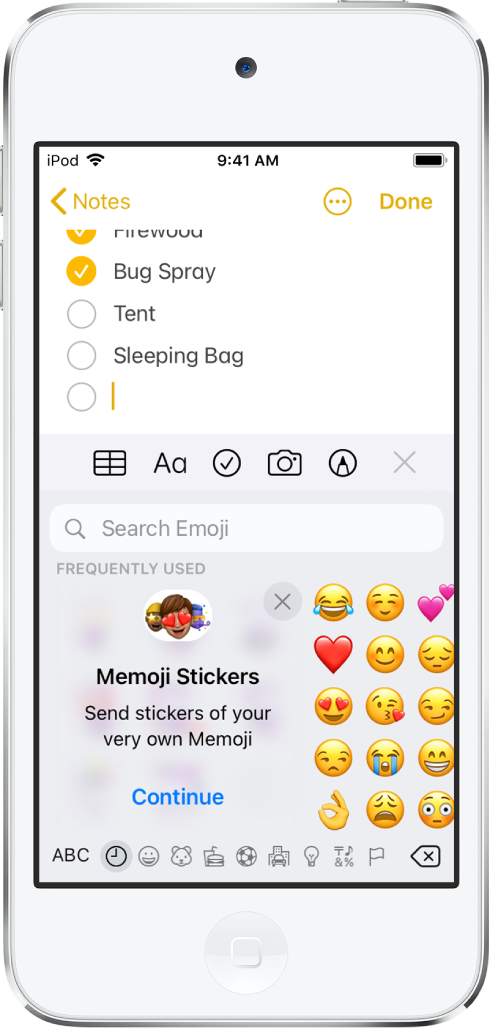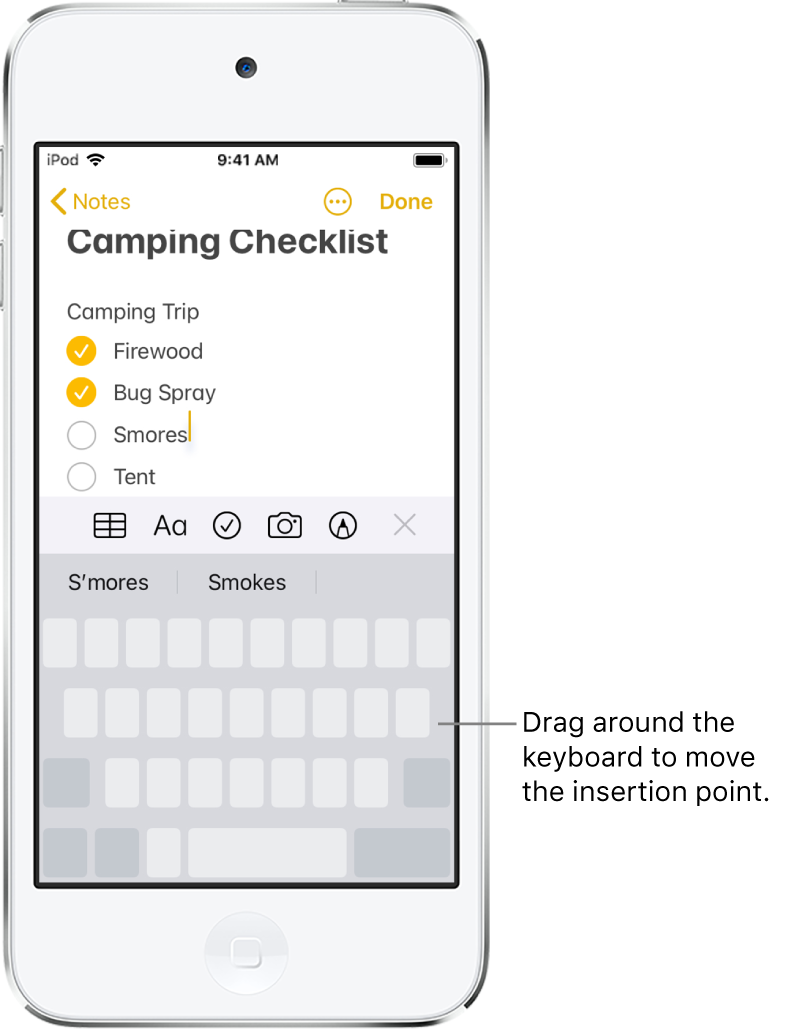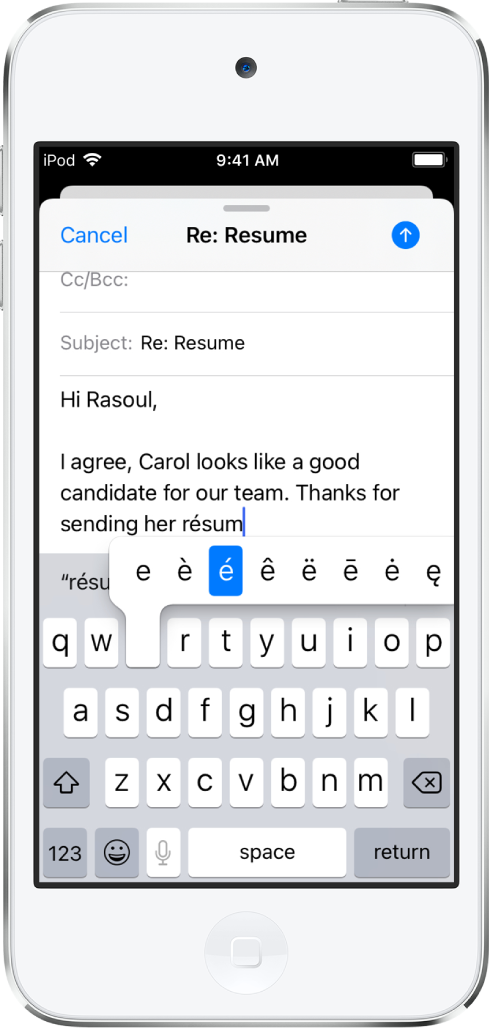iPod touch User Guide
- Welcome
- Your iPod touch
- What’s new in iOS 14
-
- Wake and unlock
- Learn basic gestures
- Adjust the volume
- Change or turn off the sounds
- Access features from the Lock Screen
- Open apps
- Take a screenshot or screen recording
- Change or lock the screen orientation
- Change the wallpaper
- Search with iPod touch
- Use AirDrop to send items
- Perform quick actions
- Use and customize Control Center
- Add widgets
- Charge and monitor the battery
- Learn the meaning of the status icons
- Travel with iPod touch
-
- Calculator
-
- View maps
-
- Use Siri, Maps, and widgets to get directions
- Choose your preferred type of travel
- Get driving directions
- Report traffic incidents
- Get cycling directions
- Get walking directions
- Get transit directions
- Change audio settings for turn-by-turn directions
- Select other route options
- Get directions between places other than your current location
- Delete recently viewed directions
- Use Maps on your Mac to get directions
- Help correct and improve Maps
- Get rides
-
- View photos and videos
- Delete and hide photos and videos
- Edit photos and videos
- Edit Live Photos
- Organize photos in albums
- Search in Photos
- Share photos and videos
- View Memories
- Find people in Photos
- Browse photos by location
- Use iCloud Photos
- Share photos with iCloud Shared Albums
- Use My Photo Stream
- Import photos and videos
- Print photos
- Shortcuts
- Stocks
- Tips
- Weather
-
- Accessories for charging iPod touch
-
- Set up AirPods
- Charge AirPods
- Start and stop audio playback
- Change the AirPods volume
- Make and answer calls with AirPods
- Switch AirPods between devices
- Use Siri with AirPods
- Listen and respond to messages
- Share audio with AirPods and Beats headphones
- Change noise control modes
- Restart AirPods
- Change the name of your AirPods and other settings
- Use other Bluetooth headphones
- Use EarPods
- Check headphone sound levels
- HomePod and other wireless speakers
- External storage devices
- Magic Keyboard
- Printers
-
- Get started with accessibility features
-
-
- Turn on and practice VoiceOver
- Change your VoiceOver settings
- Learn VoiceOver gestures
- Operate iPod touch using VoiceOver gestures
- Control VoiceOver using the rotor
- Use the onscreen keyboard
- Write with your finger
- Use VoiceOver with an Apple external keyboard
- Use a braille display
- Type onscreen braille
- Customize gestures and keyboard shortcuts
- Use VoiceOver with a pointer device
- Use VoiceOver in apps
- Zoom
- Magnifier
- Display & Text Size
- Motion
- Spoken Content
- Audio Descriptions
-
- Copyright
Type with the onscreen keyboard on iPod touch
In apps on iPod touch, you can use the onscreen keyboard to enter and edit text. You can also use an external keyboard and dictation to enter text.
Enter text using the onscreen keyboard
In any app that allows text editing, open the onscreen keyboard by tapping a text field. Tap individual keys to type, or use QuickPath to type a word by sliding from one letter to the next without lifting your finger (not available for all languages). To end a word, lift your finger. You can use either method as you type, and even switch in the middle of a sentence. (If you tap ![]() after sliding to type a word, it deletes the whole word.)
after sliding to type a word, it deletes the whole word.)
Note: As you slide to type, you see suggested alternatives to the word you’re entering, rather than predictions for your next word.
While entering text, you can do any of the following:
Type uppercase letters: Tap Shift, or touch the Shift key and slide to a letter.
Turn on Caps Lock: Double-tap Shift.
Quickly end a sentence with a period and a space: Double-tap the Space bar.
Correct spelling: Tap a misspelled word (underlined in red) to see suggested corrections, then tap a suggestion to replace the word, or type the correction.
Enter numbers, punctuation, or symbols: Tap
 or
or  .
.Undo the last edit: Swipe left with three fingers.
Redo the last edit: Swipe right with three fingers.
Enter emoji: Tap
 or
or  to switch to the emoji keyboard. You can search for an emoji by entering a commonly used word—such as “heart” or “smiley face”—in the search field above the emoji keyboard, then swipe through the emoji that appear.
to switch to the emoji keyboard. You can search for an emoji by entering a commonly used word—such as “heart” or “smiley face”—in the search field above the emoji keyboard, then swipe through the emoji that appear.
You can also dictate text or use Magic Keyboard (sold separately) to enter text.
Turn the onscreen keyboard into a trackpad
Touch and hold the Space bar with one finger until the keyboard turns light gray.
Move the insertion point by dragging around the keyboard.

To select text, touch and hold the keyboard with a second finger, then adjust the selection by moving the first finger around the keyboard.
Enter accented letters or other characters while typing
While typing, touch and hold the letter, number, or symbol on the keyboard that’s related to the character you want.
For example, to enter é, touch and hold the e key, then slide to choose a variant.

You can also do any of the following:
On a Thai keyboard: To choose native numbers, touch and hold the related Arabic number.
On a Chinese, Japanese, or Arabic keyboard: Tap a suggested character or candidate at the top of the keyboard to enter it, or swipe left to see more candidates.
Note: To view the full candidate list, tap the up arrow on the right. To return to the short list, tap the down arrow.
Move text
In a text editing app, select the text you want to move.

Touch and hold the selected text until it lifts up, then drag it to another location within the app.
If you drag to the bottom or top of a long document, the document automatically scrolls.

If you change your mind about moving the text, lift your finger before dragging, or drag the text off the screen.
Set typing options
You can turn on special typing features—such as predictive text and auto-correction—that assist you when you type on iPod touch.
While typing text using the onscreen keyboard, touch and hold
 or
or  , then tap Keyboard Settings. You can also go to Settings
, then tap Keyboard Settings. You can also go to Settings  > General > Keyboard.
> General > Keyboard.In the list, turn the typing features (below All Keyboards) on or off.
